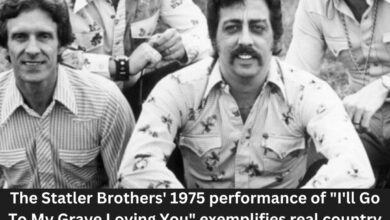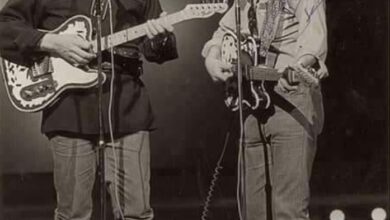Webb Pierce’s Unforgettable Interpretation of “There Stands the Glass”
“There Stands the Glass” poignantly captures the theme of heartache through its richly emotive lyrics and the powerful rendition by Webb Pierce. The song’s narrative intricately weaves the struggles of coping with heartbreak, exploring how individuals often turn to alcohol in search of solace. This imagery of a glass—steeped in the allure of liquor—serves as more than just a metaphor for drinking; it signifies a fleeting escape from emotional pain. The lyrics encapsulate the essence of loneliness, drawing listeners into the narrator’s world and evoking feelings of despair that many can relate to, especially those who have faced similar heartbreak.
The songwriting team behind this classic—Russ Hull, Mary Jean Shurtz, and Audrey Grisham—skillfully created a narrative that resonates with vulnerability and authenticity. Their collaboration culminates in a story that begins with an aching sense of longing, reflecting the narrator’s internal conflict as they grapple with sorrow while seeking comfort in the temporary relief that alcohol provides. This interplay between yearning and the indulgence in drink portrays an emotional duality that resonates deeply throughout the verses, creating a rich tapestry of sentiment that engages the listener’s empathy.
Webb Pierce emerged as a significant figure in the country music landscape during the 1950s, noted for his distinctive voice and his gift for storytelling through song. He often delved into themes of love, loss, and the bittersweet realities of life—common threads in country music that deeply resonate with audiences. Pierce’s musical approach frequently featured traditional instrumentation, especially the steel guitar, which profoundly enriched the soundscape of his songs. This depth was exceptionally relevant in “There Stands the Glass,” where the instrumental backdrop heightens the emotive quality of the lyrics, adding to the listener’s intimate experience with the music.
The green glass of liquor symbolizes both comfort and the transitory nature of relief from heartache. The song poignantly illustrates the pitfalls of seeking solace in alcohol, capturing a well-trodden path within the genre that reflects an ongoing internal struggle with pain. The emotional resonance achieved in “There Stands the Glass” echoes the universal aspects of human experience—sorrow, loss, and searching for respite—making it a relatable and enduring narrative that transcends personal stories and speaks to the collective consciousness of listeners across generations.
Upon its release in 1953, the song quickly climbed the Billboard country charts, a testament to its profound impact. This surge in popularity not only bolstered Webb Pierce’s career, solidifying his place in the annals of country music history, but also marked the song as a classic that others would seek to reinterpret. Numerous artists have since covered “There Stands the Glass,” each infusing their unique styles and emotions into the song while honoring the original’s poignant essence, showcasing its timeless relevance.
As music continuously evolves, “There Stands the Glass” maintains its powerful resonance, illustrating the intimate connection country music shares with everyday struggles and emotional truths. The song remains a staple in contemporary performances and is frequently revisited across various platforms, including radio and modern adaptations in popular culture. Its themes—lost love and an ever-looming sense of melancholy—remain as pertinent today as they were at the time of its release, reflecting the ongoing search for solace in an often turbulent world.
Webb Pierce’s enduring influence on the genre is worthy of recognition. With notable hits such as “In the Jailhouse Now,” “Love, Love, Love,” and “Wondering,” he became synonymous with the honky-tonk sound that defined much of classic country. His ability to convey profound emotion set a high standard for aspiring artists and established him as a significant figure in shaping the narrative style of country music, where storytelling often melds seamlessly with the emotional landscape of human experiences.
As Webb Pierce carved out his legacy, he embodied the principles of storytelling that continue to inspire new generations of musicians. His explorations of heartache, joy, and the complexity of relationships paved the way for future artists to draw upon these themes. In this way, “There Stands the Glass” functions not only as a lyrical narrative of personal pain but also as a touchstone in the broader context of country music’s evolution, marking it as an essential piece in understanding the genre’s storytelling tradition.
In reflecting on the significance of “There Stands the Glass,” it becomes clear that the song exemplifies more than just lyrical depth; it highlights the cultural impact and emotional resonance that country music carries. Webb Pierce’s masterful delivery and the evocative nature of the song invite listeners into a collective space of reflection, nostalgia, and shared experiences. This timeless classic stands as both a poignant reminder of past heartaches and a celebration of the human spirit’s resilience in the face of emotional challenges, ensuring its place in the heart of country music history for years to come.





